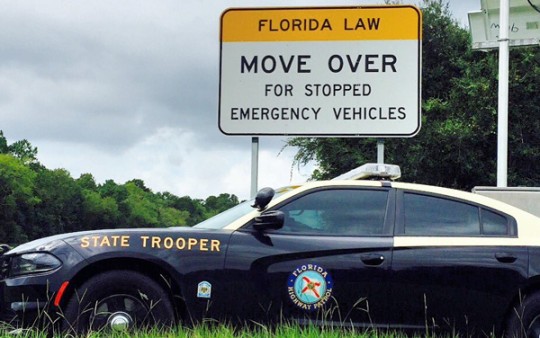January Is ‘Move Over’ Month In Florida
January 5, 2020
January is Move Over month and the Florida Department of Highway Safety and Motor Vehicles (FLHSMV) urges all motorists to move over for emergency and service vehicles stopped along the roadway. Preliminarily in 2019, there were 182 crashes and over 20,000 citations issued for motorists failing to move over. FLHSMV and the Florida Highway Patrol (FHP) are partnering with the Florida Department of Transportation, Florida Police Chiefs Association, Florida Sheriffs Association and AAA – The Auto Club Group to ensure all law enforcement, first responders, service and utility workers and Road Rangers Arrive Alive in 2020.
“When a crash occurs, law enforcement and first responders are there. When a disabled vehicle needs assistance, Road Rangers or tow truck drivers are there. When power lines need repairs, utility and service workers are there,” said FLHSMV Executive Director, Terry L. Rhodes. “The Move Over Law is in place to protect those who serve all of us on the roadways, giving them a safe space to do their jobs. Move Over, Florida, and help ensure that these public servants come home safely each day.”
When motorists cannot vacate the lane closest to the emergency or service vehicle, they must slow to a speed that is 20 miles per hour less than the posted speed limit. Failure to yield or move over puts law enforcement officers, emergency first responders and public service workers in danger while they are on the job protecting and serving the citizens and visitors of Florida.
The Move Over Law was added to Florida law in 2002. The statute, which was originally introduced in 1971, requires motorists to move or yield right-of-way to emergency vehicles and in 2014, utility and sanitation vehicles were added to the Move Over Law. The Move Over Law states that drivers must move over as soon as it is safe to do so for any authorized law enforcement, emergency or service vehicles displaying any visible signals while stopped on the roadside, including Road Rangers, sanitation vehicles and tow trucks.
“The simple act of moving over gives law enforcement, emergency first responders and other service vehicles adequate space to do their jobs and can greatly increase safety on Florida’s roadways,” said Colonel Gene Spaulding, Director of the Florida Highway Patrol. “The Move Over Law was enacted to help protect public service professionals while they protect Florida’s motorists in one of the most dangerous environments: the side of the roadway.”
To comply with the Move Over Law drivers must:
Multi-Lane Roadway:
- Vacate the lane closest to the stationary emergency vehicle, sanitation vehicle, utility service vehicle, Road Ranger or wrecker and always signal the intention to change lanes.
- Slow down to a speed of 20 mph below the posted speed limit if a driver cannot move over safely.
- Be prepared to allow those who are attempting to move over into the next lane.
Two-Lane Roadway:
- Slow down to a speed of 20 mph below the posted speed limit.
- Travel at 5 mph if the speed limit is 20 mph or less.
The public is encouraged to report aggressive drivers by dialing *FHP (*347). For more information on the Move Over Law, visit: https://www.flhsmv.gov/safety-center/driving-safety/move-over/.
Comments
2 Responses to “January Is ‘Move Over’ Month In Florida”




As of 2019 Today
All States
Except Washington DC ( go figure)
When an emergency vehicle using any visual
signal is stopped or parked on or next to a roadway, drivers approaching the emergency vehicle
should (1) make a lane change into an available lane not immediately adjacent to the emergency
vehicle; or (2) if unable to safely make a lane change, slow down to a reasonable speed for existing
weather, road, and vehicular or pedestrian traffic conditions.
Blue or Red flashing lights are the signs..if your not on a cellphone or drunk or medical emergency …or not paying attention
Road flares and cones …all the above
Common sense above all
What the state needs to do is put more signs out there. There are not enough notification signs on highways to alert drivers of the warning especially if they are out of state and don’t know the law.